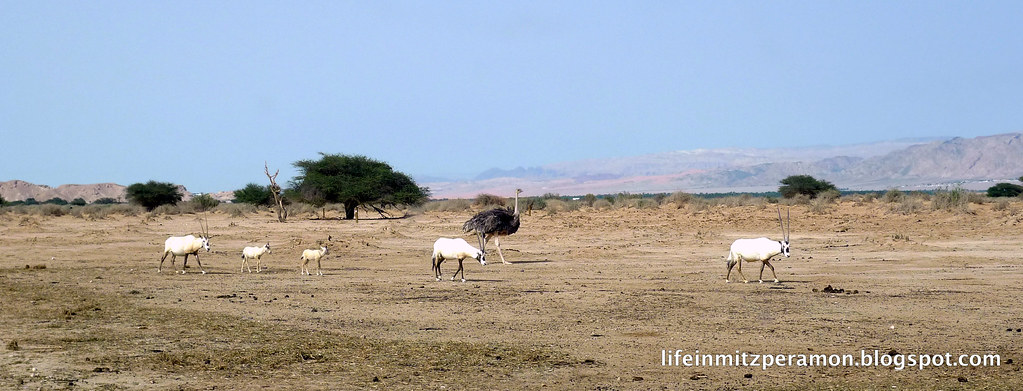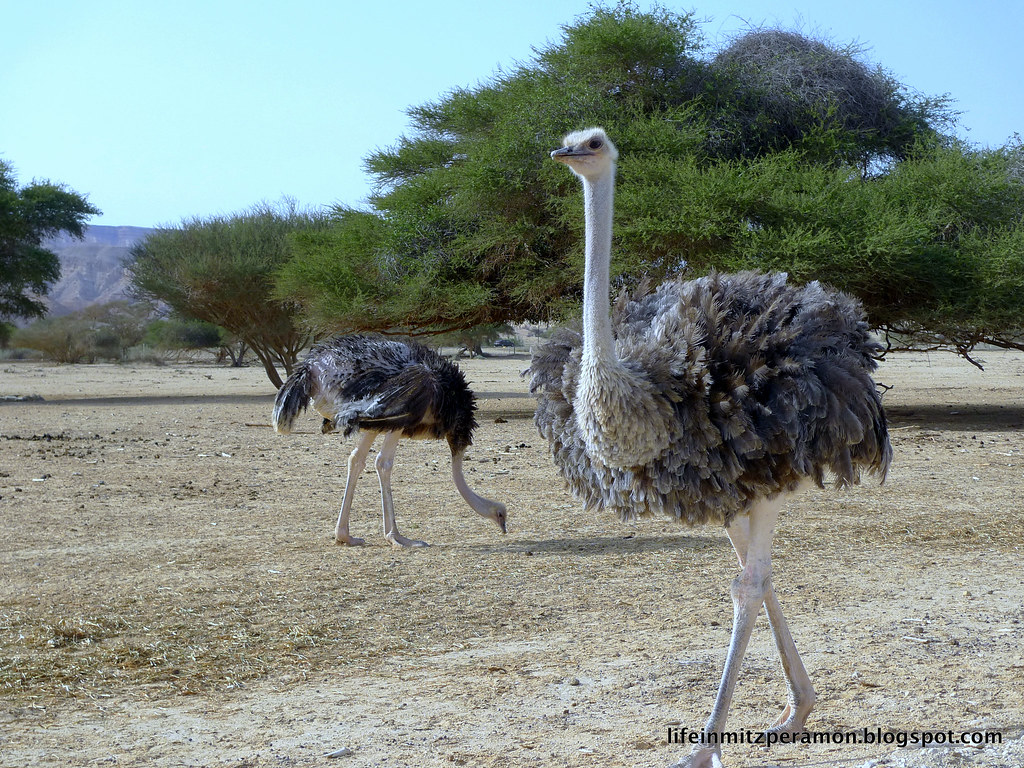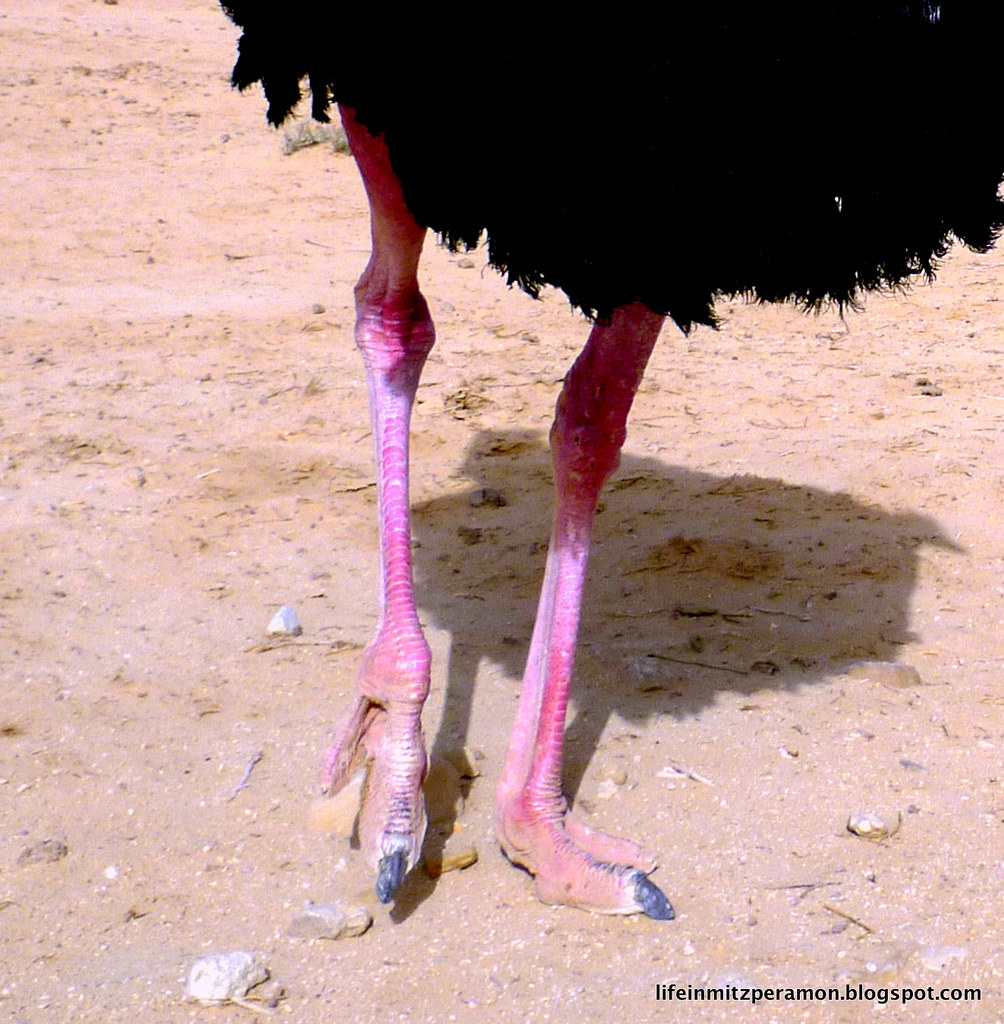When we were there in early April the safari tour was at 4:00PM, but you should call to double check because this safari is the best part of Chai Bar. One does not often get to see herds of wild desert animals up close. And the ostriches are perhaps the closest thing on can get to a Jurassic Park experience this side of Stephen Spielberg's movie.
An Oryx in the Chai Bar Reserve (Click for full size image.).
It must have been truly amazing in the days when these animals ran wild in the Negev to see a group like this.
A small herd of adult and baby Oryx together with a female ostrich.
The Addax, while not native to the Negev, is in danger of extinction, so the Chai Bar's efforts at preservation will not result in the release of the animal back into the wild in Israel.
A herd of Addax
The onager, the brown Asian wild ass, can be distinguished by the dark stripe down its back. It has been successfully reintroduced to the Negev and wild herds can be seen in Machtesh Ramon and the surrounding area in the summer. In the winter the herds disperse over large areas.
Onager, the Asian wild ass
But the most bizarre and pre-historic looking of all the animals in the preserve are the ostriches. The ostrich, which cannot fly, is the largest and fastest of birds, able to run at speeds up to 45 mph. It also lays the largest egg of any living bird. It uses its wings to balance and maneuver while running at high speed. The female is a bland grey, but the male is prized for its colorful black and white tipped feathers, and it has a flaming red skin color, all of which make it look like a pre-historic beast when seen in the wild of the Arava Valley.
Female ostrich
Male ostrich
The ostrich's huge two-toed foot (the only bird to have two toes), which looks like it came off a dinosaur, and its propensity to attack automobiles on the safari make for a great "Jurassic Park" experience for the children. Be prepared to roll up your window fast!
The Ostrich's huge, two-toed foot is used to propel itself at high speed and to strike viciously at enemies. You do not want to be on the wrong side of this toe. VERY prehistoric!
A Jurassic Park moment at the Chai Bar Preserve.
The ostrich is a biblical animal, mentioned in the Book of Job by Elihu son of Barachel the Buzzite in his reprimand of Job for doubting the moral order of the universe (Job 39):
The ostrich lays its eggs on the ground where they may be trampled. The male also mixes up eggs from different nests, so the mothers do not know which is theirs. ("She is hardened against her young ones, as though they were not hers: her labour is in vain without fear.") And when the male is frightened he will rise suddenly without regard for the eggs which he sometimes sits on and will heedlessly crush them. (Sounds like the perfect national bird for the mythical Palestinian state.)13: Gavest thou the goodly wings unto the peacocks? Or wings and feathers unto the ostrich?14: Which leaveth her eggs in the earth, and warmeth them in dust,15: And forgetteth that the foot may crush them, or that the wild beast may break them.16: She is hardened against her young ones, as though they were not hers: her labour is in vain without fear;17: Because God hath deprived her of wisdom, neither hath he imparted to her understanding.18: What time she lifteth up herself on high, she scorneth the horse and his rider.
The ostrich's eye is larger than its brain.
The eye of the ostrich is larger than it's brain, partly giving rise to the thought that they are witless. ("Because God hath deprived her of wisdom, neither hath he imparted to her understanding.") But in addition they engage in actions that seem silly and stupid to us. They are attracted to shiny objects, which may be why they "attack" and peck at automobiles on the safari tour. Ostriches will eat just about anything found shiny on the ground, and they have been found to have coins, earrings, jewelry, and even spark plugs in their stomach.
An ostrich attacks a "shiny" car at the Chai Bar Nature Preserve
In ancient times ostriches were hunted down by a group of riders closing-in on the ostrich from all sides. The ostrich would run madly back-and-forth between the riders until, exhausted, it would lay its head on the ground. This is where the expression "burying your head in the sand" comes from during times of trouble, for it looks like the ostrich has done just this as its captors approach. But this may also be a ruse, since the ostrich's most vulnerable body part, the long neck by which it may be captured, is kept out of harm's way. But as soon as the riders close in for the kill the ostrich is up and away using its great speed to out distance them. ("What time she lifteth up herself on high, she scorneth the horse and his rider.")
Ostrich photo set
The Chai Bar Nature Reserve - definitely worth a trip on its own, but its proximity to Eilat makes it a bonus for a trip there.














No comments:
Post a Comment